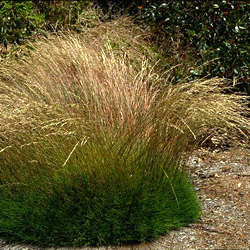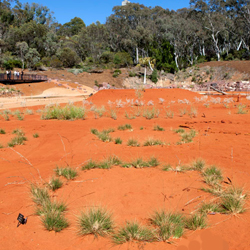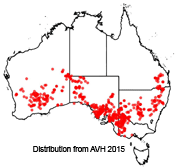Triodia scariosa
 |
 Planted in circles in the ANBG's Red Centre Garden. |
Porcupine Grass
Triodia scariosa, commonly known as Porcupine Grass, is a hummock- or tussock-forming perennial belonging to the family Poaceae.
The genus Triodia consists of 65 species, all of which are endemic to Australia. Covering approximately a third of the continent, Triodia hummock grasslands form a dominant vegetation type throughout both the arid and semiarid regions of Australia. Triodia scariosa occurs across all mainland states in temperate regions. The species is common to mallee and hummock grassland communities, with individuals forming dense, often impenetrable stands. It occurs on a range of calcareous, clayey and siliceous soils.
Growth of the species occurs via stolons, which are horizontal above-ground stems that are anchored in the soil by roots. Triodia scariosa does not produce resin unlike some other members of the genus Triodia.
The most notable feature of the genus Triodia is its ability to form spreading ring or crescent structures, spanning up to 3 meters in diameter. In nature these form over many years, as the plant ages and the roots repeatedly die out towards the centre. In grasslands, where there is sufficient age and density of plants, rings may begin to join up to form a reef-like pattern. Because of the time taken for these structures to occur naturally, rings or crescents may be mimicked when cultivating by artificially planting clumps into the desired shape during establishment.
When in flower the species is particularly attractive. Its inflorescence is a panicle, which extends well above the foliage. Flowering culms, 45 cm to 1m in height, may be typically seen from late spring to early summer in response to rain.
The sharp, needle like leaves, up to 25cm long, are best admired from afar. They may be grey to green in colour and tend to pale off in drier environments. The needle like leaves of Triodia scariosa make it useful for establishing barriers to plant beds in order to protect other plants from being eaten or trodden on.
Other than being aesthetically pleasing, porcupine grass is also an important provider of habitat, allowing native species to seek refuge from predators such as feral cats and foxes. It also forms an extensive root system. This provides mechanical support for the soil by holding it together as well as retarding water, making it useful in the prevention of erosion.
The preferred method of propagation for the species is through division. This is achieved by taking a healthy clump of roots and leaves, from a relatively young individual, and sectioning it out into smaller clumps for planting. For best results, watering upon establishment is recommended.
Once established, plants require little maintenance but will respond well to some fertiliser as well as water. Plants are resistant to both frost and drought and may be pruned to containment without detriment.
Stephanie Johnson, Botanical Intern 2015
Name meaning: Triodia scariosaTriodia - from the Latin tri-, meaning three, and odous, meaning tooth, alluding to the three lobes or teeth found on the lemma scariosa - derived from the word scarious meaning thin, dry and parchment-like, in reference to the texture of the glumes |
References:
Gamage,H.K., Mondal, S., Wallis, L.A., Memmott, P., Martin, D., Wright, B.R. & Schmidt, S. (2012) Indigenous and modern biomaterials derived from Triodia (‘spinifex’) grasslands in Australia. Australian Journal of Botany 60: 114–127.
Wrigley, J.W. & Fagg, M. (2013) Australian Native Plants: Cultivation, Use in Landscaping and Propagation (Sixth Edition), New Holland Publishers, Frenchs Forest, NSW.
Jessop, J., Dashorst, G.R.M & James, F.M. (2006) Grasses of South Australia: An illustrated guide to the native and naturalised species,Wakefield Publishers, Kent Town, South Australia.
G.J Harden (1993) Flora of New South Wales: Volume 4, New South Wales University Press, Kensington, NSW.
Australian Government Department of the Environment and Heritage (2005) Flora of Australia: Volume 44B Poaceae 3, ABRS, Canberra/CSIRO Publishing, Melbourne.
Cunningham, G.M., Mulham, W.E., Milthorpe, P.L. & Leigh, J.H. (1981) Plants of New South Wales, N.S.W Government Printing Office in association with the Soil Conservation Service of N.S.W, Australia.
Maggie Nightingale (2015) Australian National Herbarium, personal communication.
Mark McMahon (2015) ANBG horticulturalist, personal communication.
![An Australian Government Initiative [logo]](/images/austgovt_brown_90px.gif)


